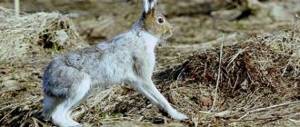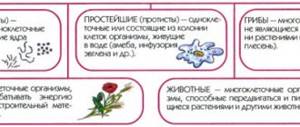Interactive games around the world, grades 1-2
Didactic games about the world around us using the DragAndDrop template for students in grades 1 and 2
Author: Nadezhda Vladimirovna Ryabichenko, primary school teacher at the Mikhailovskaya Secondary School, Kikvidzensky district, Volgograd region Description of the material: This material is intended for students in grades 1 and 2. Can be used by the teacher in lessons about the outside world, in extracurricular work on the subject. It is possible to use interactive games with preschool children. Goal: to consolidate children's knowledge about nature, about the relationships between living and inanimate nature. Objectives: to develop cognitive interest, independence, observation, logical thinking, memory, the ability to creatively search, and the ability to find ways to solve a given problem.
Working with the DragAndDrop template. Once you open the program, click Slide Show
, select
From Beginning
or
From Current Slide
.
Then in the Security Alert
select
Enable this content
, click
OK
.
There is no need to save changes after finishing work and exiting the program. "Who lives where"
In this game you need to correctly match the birds and their housing. To do this, click on any picture with the left mouse button once and move it. Then left-click again. You can move both the illustration of the bird and its housing. Answers:
woodpecker - in a hollow; magpie - in a nest in a tree, its nest has a spherical shape; swallow - in a nest under the roof of a house or barn; lark - in a nest that he made on the ground, among the grass; The duck built its nest in the thickets near the water. Variant of illustrations arrangement:
"Who eats what"
In the game you need to correctly match the illustration of the animal with what it eats (for each animal, choose only one illustration with the food item). You can move both a picture of an animal and a food item. Answers:
hare - grass, bear - fish, hedgehog - bird eggs, fox - mice, squirrel - mushrooms. Variant of illustrations arrangement:
“Where does which berry grow?”
Correctly match the berries and the area in which they grow. Just like in previous tasks, you can move any picture. Answers:
raspberries, strawberries, blackberries - in the forest, cloudberries, cranberries, blueberries - in the swamp. Variant of illustrations arrangement:
“What mushroom?”
In the game you need to choose an illustration of an edible or inedible mushroom and move them correctly, arranging them in two columns. Edible mushrooms:
white mushroom, porcini mushroom, chanterelle, honey mushroom, champignon, russula, boletus.
Inedible mushrooms:
false mushrooms, panther fly agaric, red fly agaric, satanic mushroom, toadstool. Variant of illustrations arrangement:
"Collect a picture"
You need to assemble an illustration with a picture from parts. If a child has difficulty completing a task, he can use the hint located on the right, in the upper corner of the slide. Clicking on the word hint will open an illustration. During further work to create a complete picture, the illustration is closed again. Answer:
"Living - nonliving"
In this game you need to identify objects of living and inanimate nature and place them in two columns: on the left - what relates to living nature, on the right - what relates to inanimate nature. Answers: Objects of living nature:
man, insect (grasshopper), flower, grass, mushroom
Objects of inanimate nature:
sun, water, stones, hail, rainbow. Variant of illustrations arrangement:
Presentation on the topic: Interactive games around the world around us
We recommend watching:
Game for elementary school students “Animals of the Urals” with a presentation Games for 1st grade Game for elementary school students with a presentation on the topic: Insects Lesson summary - art games for elementary school students 1-2 grades
Similar articles:
Game "Field of Miracles" in 4th grade. Inventions
Game Lucky Chance, 4th grade
Game "Lucky Chance" for elementary school, grades 3-4
Game "Clever and smart girls" in elementary school
Game “What? Where? When?" for elementary school. Questions and answers
Didactic games in the lessons “The world around us”, or How to develop motivation in elementary school
Bibliographic description:
Pavlovskaya, N.K. Didactic games in lessons “The world around us,” or How to develop motivation in elementary school / N.K. Pavlovskaya. — Text: immediate // Pedagogy today: problems and solutions: materials of the I International. scientific conf. (Chita, April 2020). — Chita: Young Scientist Publishing House, 2020. — pp. 101-104. — URL: https://moluch.ru/conf/ped/archive/213/12169/ (date of access: 10.10.2020).
One of the main tasks of schoolchildren that the school sets for them is that they learn to study. In this regard, motivation is formed in all lessons, and such a subject as “The World Around us” is no exception. In the process of developing motivation in this lesson, the teacher faces a number of difficulties. This is primarily due to the fact that the academic subject is integrated, that is, it includes the study of several disciplines at the propaedeutic level, with the aim of better assimilation in middle and high school. Therefore, there is a need to choose a way to develop learning motivation, the most optimal of which is a didactic game.
Purpose of the study: to study the features of the development of motivation when using the didactic game in the lessons “The world around us” in elementary school.
A. A. Radugina gives the following definition of the concept of motivation: “Motivation is a set of motives (inducements to action) that influence human behavior. Motivation to learn is the main condition for successful learning; this is due to the active role of the child’s interest and desire in acquiring new knowledge” [3, p. 120]. In order to ensure that interest in learning does not decrease, but rather increases and is maintained, they turn to didactic games.
According to E. A. Volokhova, the game is the fastest and most effective way for students to acquire knowledge about the world around them. Using the game, we accelerate and strengthen the process of child development, his introduction to social values [1, p. 187]. Games are familiar to primary schoolchildren from early childhood, so their inclusion in the educational process is especially important in the first year of schooling, when the difficult transition from preschool to primary school age occurs.
Didactic games are a type of games with rules, specially created by a pedagogical school for the purpose of teaching and raising children. Didactic games are aimed at solving specific problems in teaching children, but at the same time, the educational and developmental influence of gaming activities appears in them [1, p. 162]. The purpose of didactic games is to develop students’ ability to apply acquired knowledge in practice.
The didactic game is present in almost all lessons in the surrounding world and is part of an integral pedagogical process, combined and interconnected with other forms of teaching and upbringing of younger schoolchildren. A properly constructed, interesting didactic game ensures that children develop motivation to acquire new knowledge. For example, the participants of the team that lost the quiz will want to win next time, and during the lesson they will listen carefully to the teacher because the questions, riddles and competitions of the previous quiz will be related to the topic of the lesson.
The merit of the didactic game is that it is carried out in a team; children are divided into groups, which allows students to solve problems of a higher level, as well as to unite the team. In addition, during the game, children compete and strive to complete tasks faster than the other team.
In order for didactic games in lessons around the world to develop positive learning motivation (desire to learn) in children, they must be based on games familiar to children. For this purpose, it is necessary to include in quizzes, KVNs, and quests those didactic games that, on the one hand, will contain an element of novelty, and on the other hand, the rules for which will be feasible for children.
The emotional state of the teacher is also important, which must correspond to the activity in which he participates. Unlike all other methodological means, didactic games require a special state from the one who conducts it. It is necessary not only to be able to conduct didactic games, but also to be involved in gaming activities with children.
Didactic games include different ways to develop motivation. This is facilitated by the joint solution of game problems, which is aimed at communication between students in the lesson (motives for communication). The didactic game contains a riddle - an unanswered answer, which activates the student’s mental activity and promotes an independent search for an answer (cognitive motives).
In didactic games, motives are replaced: students act out of a desire to enjoy the game, and as a result, in addition to this, they gain new knowledge and develop their mental processes. In games, students achieve goals at different levels.
At the first level, there is pleasure in the game process itself. This goal reflects an attitude that determines readiness for any activity if it brings satisfaction. At the second level, the functional goal is achieved, which consists in fulfilling the rules, playing out plots and roles. At the third level, students achieve a pedagogical goal by solving game problems. [3, p. 154].
For the formation and development of positive sustainable motivation for learning activities in the lessons of the surrounding world through the use of didactic games, it is important that the main thing in the student’s assessment of his activities is a qualitative analysis of his work during the didactic game. At the same time, it is necessary to emphasize all the positive aspects that helped students cope with the task in the game, as well as pay attention to the reasons for the existing shortcomings. Thus, students will understand that taking an active part in the game and helping your team is much easier and more interesting if you have a certain amount of knowledge acquired during the lesson.
By using didactic games in lessons around the world, the teacher creates situations in which students can independently evaluate their results and draw their own conclusions about their successes or failures in any specific activity. When using such games, a “success situation” is created, which helps to increase the student’s self-esteem and psychological stability.
You should not evaluate the didactic game only from the standpoint of teaching students. Its value lies primarily in the fact that it serves as an emotional release and prevents fatigue among younger schoolchildren. [3, p. 163]. During the game, children, while taking a break from educational activities, consolidate or gain new knowledge about the world around them.
In primary school, to develop motivation in lessons about the surrounding world, the most common types of didactic games are: games with objects (toys, natural materials) and verbal games (crosswords, quizzes, riddles, puzzles).
Let's look at examples of didactic games.
“Leaf” (didactic game with natural materials)
Students are divided into two teams, the teacher takes turns showing the leaves of the trees. The children's task is to correctly name which tree the leaf comes from. The team that gives the most correct answers wins. This didactic game can be played both for the purpose of consolidating and testing students’ knowledge.
“Great catch” (didactic game using pictures)
Each picture of a different fish has a paperclip attached to it. The “fish” are placed in an aquarium (you can use a regular box). Students go out to the aquarium one by one, the teacher gives them a fishing rod with a magnet at the end. Students catch a fish and tell them everything they know about it. Everyone else listens carefully, after the student has told everything, he asks questions to the class. The teacher records who answers and assigns points for correct answers. The one who scores the most points wins. The game can be played to test knowledge after studying the “Fishes” section, as well as to test students’ existing knowledge in this section before starting to study it.
“Habitat” (didactic game, carried out in the main part of the lesson)
To play the game, you need a playing field, which is a desk, on the desk there are sheets of paper (different territories), on which the name of the country and the conditions characteristic of this territory are written. Each student is given several cards with the corresponding name of the type of living organism and its requirements for the habitat. The students' task is to settle different types of organisms into territories suitable for them, while explaining why this particular territory was chosen. For each correct completion of a task, the student receives 5 points; for each incorrect task, 5 points are deducted. The one with the most points in total wins.
As requirements for the environment, either one or several preferences can be taken into account, thereby, depending on the number of factors, the degree of difficulty for students will change.
The didactic task of this game is to give children the knowledge that the distribution of living organisms in certain territories is not accidental, but is determined by the presence of necessary factors and the absence of factors unacceptable to them. This knowledge is necessary for students to form one of the most complex ecological concepts - “environment”, for students to understand the role of natural conditions in the life of organisms, the reasons for the formation of flora and fauna, the existence of habitats, and possible reasons for the disappearance of organisms from their former habitats.
A quiz is a verbal didactic game of answering questions united by a common theme. Students are divided into teams and compete with each other to see who can answer the questions the fastest.
A riddle is an image or expression that needs to be solved. The use of riddles in lessons about the world around them arouses keen interest in children and thus they actively participate in the lesson, thanks to which learning motivation develops. The riddle can be used in any part of the lesson.
“Living Letters” (didactic game using riddles)
Students are divided into two teams. Each player is given a card with one of the letters: (A, B, G, E, I, K, L, N, O, P, R, S, C, H, Z) which is attached to the chest. The teacher reads the riddle, and the students, having guessed it, try to quickly stand in a row so that they can read the guessing word. The team that completes the word faster gets a point. The team with the most points wins.
This educational game may include riddles on various topics. Let's look at examples of riddles on the topic: “Birds”.
All the migratory birds are black, clearing the arable land of worms, back and forth across the arable land, jumping, and the bird’s name is…. (Rook)
The firebird has spread its tail, It burns and turns golden. From overseas valleys to us. This tail brought... (Peacock)
He stands on one leg and looks intently into the water. Poking at random with its beak - looking for frogs in the river.
A drop hung on my nose. Do you recognize? This…. (Heron)
The night is pitch black. The gray bird has no time for sleep: it glides between the bushes like a shadow, keeping watch for those who are not sleeping. He catches every rustle sensitively, but when he screams, it becomes creepy. The sleeping grass will tremble. This is wow... (Owl)
Together we built a spring house for guests, or rather a palace. Come quickly, ... (Starling)
The above didactic games, as well as many others, help to activate the interest and attention of younger schoolchildren in lessons about the world around them, develop cognitive abilities, imagination, form educational skills, self-control and self-esteem skills, independence in academic work, contribute to the consolidation of knowledge, skills and the formation of skills.
Thus, the variety of didactic games determines their choice as the most effective means of developing the motivation of primary school students in the “World around us” lessons.
Research results. The paper examines the features of the development of motivation of younger schoolchildren when using the didactic game in the lessons “The World Around us”. The essence, purpose and examples of didactic games used in “The world around us” lessons in elementary school are described. Their role in developing primary schoolchildren’s interest in the subject and desire to expand and deepen knowledge is substantiated.
Conclusions. Primary school age is the beginning of the development of learning motivation. It is necessary to develop motivation in every lesson. Lessons from the surrounding world are interesting for children due to their diversity, since the subject is integrated, and to maintain this interest, it is most advisable to use a didactic game. Such a pedagogical tool as a didactic game activates the mental operations of students, forms in them a cognitive interest in acquiring new knowledge, an interest in competitive activity and a desire to win, which contributes to the formation of sustainable educational motivation for learning in younger schoolchildren in the “World around us” lessons.
Literature:
- Volokhova, E. A. Didactics. Lecture notes / E. A. Volokhova, I..V. Yukina. - Rostov-on-Don: Phoenix, 2004. - 288 p.
- Grigorieva, E. V. Methods of teaching natural science in elementary school: textbook. manual for pedagogical students. universities / E. V. Grigorieva. — Chelyabinsk: Chelyab. state ped. univ., 2020. - 283 p.
- Radugina, A. A. Psychology and pedagogy: textbook. manual for universities / A. A Radugina. - Moscow: Center, 2003. - 256 p.
Key terms
(automatically generated)
: didactic game, game, world around, student, lesson, riddle, knowledge, team, primary school, child.








